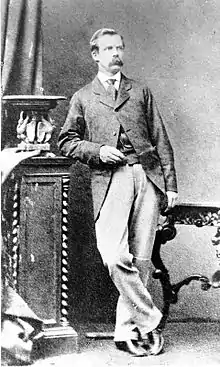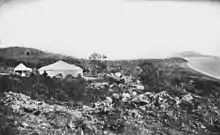John Melton Black
John Melton Black (1830–1919) was a pioneer of Townsville, Queensland, Australia. Black ordered the expedition of Cleveland Bay to find a suitable site for a port and then established the Port of Townsville and the associated town of Townsville. He served for two terms as Mayor of Townsville.[1]

Early life
Black was born in Edinburgh, Scotland in 1830, the son of a physician. Black become a merchant and moved to London. It was there that he heard of the Australian goldfields.[1]
Victoria
Black immigrated to Melbourne where he made his fortune, not by mining gold but by establishing a business as a carrier. In 1855 he established the first Theatre Royal in Melbourne on the north side of Bourke Street, able to hold more than 3000 people. The opening production was The School for Scandal. Although described as a "magnificent theatre", the £60,000 cost of the theatre's construction ultimately bankrupted Black.[1][2][3]
Queensland

Black was attracted to the opportunities of the new colony of Queensland. With W. A. Ross, C. S. Rowe and W. Longshaw, he formed a group to go furthest north and take up pastoral land. They reached Bowen on 18 April 1861, where they founded Fanning Station. This was near the site of the Macrossan Bridge. Black was claimed to be the first man to cross the Burdekin River with flocks and herds. He liked the prospects of North Queensland and at the end of 1863, he took up a further large area of land, which became known as Woodstock Station. However, harsh conditions forced him and many others to surrender their lands to the banks as they were unable to meet their heavy mortgage commitments. Then aged 34, he became general manager for Robert Towns' pastoral interests, which included Fanning, Woodstock, Inkerman, Jarvisfield and other large holdings. Headquarters were established at Woodstock, and the long haulage of goods from Bowen was found troublesome. On the map it could be seen that the nearest coast was but twenty miles away. When Andrew Ball and Mark Watt Reid were sent to explore, they made the discovery of Ross Creek in 1864.[1]
The new work of forming a port at Cleveland Bay and the establishment of the settlement of Townsville was undertaken by a partnership of Towns and Black. Black is credited with erecting the first wharf, surveying the first allotments and supervising the erection of its first buildings. He is said to have built the first house in Townsville. He was a stockman, merchant, surveyor, newspaper editor and pioneer of the meat industry in Townsville and surrounding districts. He served for two terms as Mayor of Townsville.[1]
Later life
Black left Townsville at the end of the year 1867, and his loss was keenly felt by the residents of North Queensland. As there had been no farewell ceremony, it was arranged to send him presents of an illuminated address and a valuable gold cup. From Sydney he proceeded to Europe, where he made an extensive tour before settling down in London. There he established a printing business.[1]
At Hanover Square, London, he had married Marion O'Dowds, whom he first met in Townsville. Their family consisted of five sons and a daughter. Black died in 1919 aged 89 years.[1]
Legacy
On Sunday 1 November 1964, a monument commemorating the "100th Anniversary of Settlement in Townsville" was unveiled on The Strand, with particular mention made of four men: Robert Towns, Andrew Ball, Mark Watt Reid and John Melton Black.[4] As at 2020, the monument is located in Anzac Memorial Park between the Centenary Fountain and the bandstand (19.2553°S 146.8230°E).[5]
Black River (both the river and the suburb of Townsville) are named after him.[6][7] Melton Hill (the 50-metre hill) in Townsville City was named after him and was the name of the first land sale in Townsville; Black's home was on the top of Melton Hill.[8] The road to the Townsville Airport is called John Melton Black Drive.
References
- "JOHN MELTON BLACK". Townsville Daily Bulletin. Qld. 10 July 1934. p. 7. Retrieved 17 January 2016 – via National Library of Australia.
- Melbourne, School of Historical Studies, Department of History, The University of. "Theatre Royal – Entry – eMelbourne – The Encyclopedia of Melbourne Online". www.emelbourne.net.au. Retrieved 17 January 2016.
- "THE THEATRE ROYAL". The Argus. Melbourne. 10 July 1855. p. 5. Retrieved 17 January 2016 – via National Library of Australia.
- "100th Anniversary of Settlement in Townsville". Monument Australia. Archived from the original on 14 June 2020. Retrieved 14 June 2020.
- "Anzac Memorial Park". Google Maps. Retrieved 14 June 2020.
- "Black River – river (entry 2913)". Queensland Place Names. Queensland Government. Retrieved 17 January 2016.
- "Black River – suburb (entry 44571)". Queensland Place Names. Queensland Government. Retrieved 17 January 2016.
- "A brief history of suburb names" (PDF). Townsville City Council. Archived from the original (PDF) on 23 April 2012. Retrieved 17 January 2016.
Attribution
![]()
![]() This Wikipedia article contains text from John Melton Black by W. J. Doherty published in the Townsville Daily Bulletin on 10 July 1934 page 7 (public domain in Australia via Trove).
This Wikipedia article contains text from John Melton Black by W. J. Doherty published in the Townsville Daily Bulletin on 10 July 1934 page 7 (public domain in Australia via Trove).
Further reading
- Brumby, Michael; Brumby, Michael (2014), Black to gold : from gateway to golden lands : the true story of the founding of Townsville by John Melton Black to the finding of gold at Charters Towers, Charters Towers, Qld. Charters Towers Archives, ISBN 978-0-9579009-7-4
- Gibson-Wilde, Dorothy M. (2009), "Townsville's Neglected Founder: The Mysterious Mr Black", Sir Robert Philp Lecture Series : selected lectures on North Queensland history from the CityLibraries (PDF), Townsville City Council, pp. 104–115, ISBN 978-0-9807305-2-4, archived (PDF) from the original on 14 June 2020